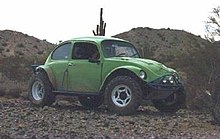Baja bug
The Baja Bug is a VW Beetle that has been converted for use in the field (deserts, sand dunes and beaches). Other air-cooled Volkswagens are also sometimes converted in this way.
history
The Baja Bug was originally launched in Southern California from 1969 to 1975 as an inexpensive answer to the successful VW buggy from the mid-1960s, e.g. B. the Meyers Manx , built.
The first Baja Bug is said to have been manufactured by Gay Emory from Parts Obsolete around 1968. Dave Deal , the well-known Californian cartoonist, is said to have used it for the first time in a competition in the Mexican 1000 in 1968. The first GFK -Baja (Bug Eye Kit) was only introduced in 1969 by the Miller-Havens Company .
Before the introduction of GRP parts, enthusiasts and racing drivers simply rebuilt an old VW Beetle in terms of the body and technology so that it was suitable for use in rough terrain. The front fenders and side panels of the car were partially cut off, resulting in higher ground clearance and greater suspension travel. These cars were known as the Cut Baja . A higher engine performance was achieved through the use of cylinder heads with double intake manifolds and VW Type 3 injection systems .
Reasons for the Beetle as a donor vehicle
The Beetle was popular in the less developed areas of the world because of its rear-mounted, air-cooled engine, flat underbody, and robust torsion bar suspension . In fact, contemporary advertising suggests that the beetle is waterproof enough that it would swim. These attributes predestined the Beetle as the basis for an off-road vehicle, as the successes of the car in the Baja 1000 prove then and now.
modification
The basic remodeling is easy. The front and rear fenders, as well as the trunk lid, bonnet and side panels are removed and replaced with GRP parts. The rear engine is not disguised to ensure better cooling. A tubular steel cage and a bumper each are attached to the front and rear to protect passengers and the engine. The running boards are also removed and instead GRP fenders and side reinforcement tubes made of steel are attached. The robust torsion bar suspension enables the Beetle to defy the rough terrain conditions and allows its owner to slightly increase the ground clearance at the rear and to stiffen the chassis so that the larger terrain wheels can be attached. With its relatively light front, the Beetle can partially compensate for the lack of all-wheel drive . The larger tires allow even greater ground clearance and better driving comfort on rocky terrain. The impact protection can be removed to increase the spring travel. Longer shock absorbers allow even greater spring travel and more damping performance and improve the driving characteristics. Some people even remove the torsion bar suspension and replace it with struts for even greater travel.
The Baja Bug today
Although the Baja Bug has largely been replaced in recent years by specially designed buggies with tubular frames, the sandrails, as the basic vehicles are slowly running out, this type remains a popular option in desert regions, especially since only a few beaches are approved for public traffic in the USA are. Many specimens are equipped with heavily tuned VW engines and some specimens also have engines from the Ford Pinto , the Chevrolet Corvair , Porsche , Mazda or Subaru , as well as other water-cooled four, six or eight-cylinder engines. Tuned street versions of the Baja Bug are also very popular.
In 2000, Volkswagen tried to revive the Baja Bug with the Dune Concept.
One manufacturer is Baja Bug Brasil from Brazil .








